Dental Bridges – Bedford, TX
A Way To Fill In The Gaps
Missing one or two teeth can severely hamper your ability to eat, chew, and even talk properly. Thankfully, our team here at Omega Dental of Bedford can use dental bridges as a way to fill the gaps in your smile.
This style of restoration is strong, sturdy, and meticulously crafted to blend in perfectly with the rest of your smile. If you want to know how it feels to have all of your teeth again, call us today and we’ll bring you in for a consultation.
Why Choose Omega Dental of Bedford For Dental Bridges?
- Restorations Crafted from the Highest Quality Materials
- Fast Appointments With Very Little Wait Time
- Implant Bridge Placement Performed In-house
What is a Dental Bridge?
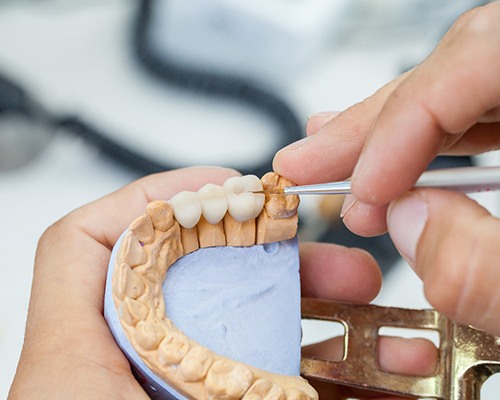
Broadly speaking, a dental bridge consists of two dental crowns that have another false tooth sandwiched between them. When you place this “bridge” on either side of a gap in your teeth, the restoration will take the place of a tooth that you’ve lost.
Dental bridges tend to be made of dental ceramic, which can be color-matched to blend in perfectly with your other smile. They’re perfect for replacing one or two teeth that were previously right next to each other, especially if the rest of your pearly whites are fairly healthy.
Types of Dental Bridges
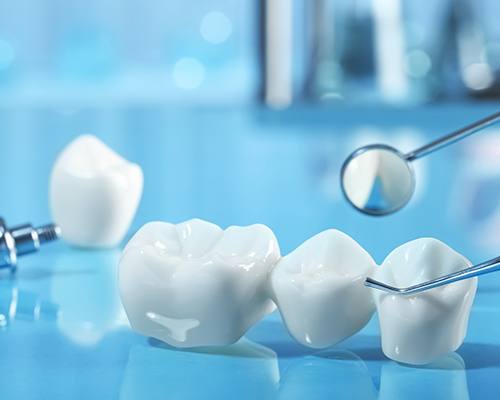
Dental bridges can replace missing teeth in a variety of ways, and which method is best for you depends on your unique circumstances. We’ll talk with you about which type suits you best at a consultation, but here’s a brief summary of what kind of dental bridges we offer.
Traditional Dental Bridges
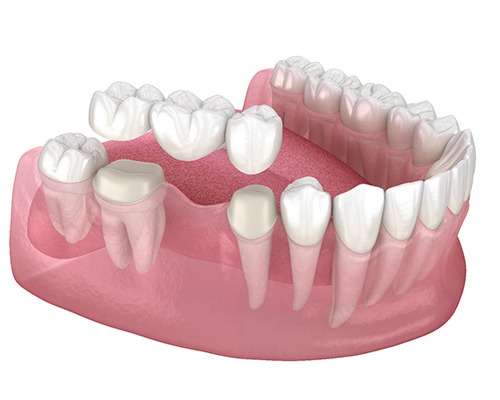
Traditional dental bridges make use of two dental crowns that are placed over the teeth. This is a great solution if you have teeth surrounding the void in your smile that are healthy enough to handle a dental crown. They’re quick, easy, and provide you with a remarkably strong bite.
Implant Bridges
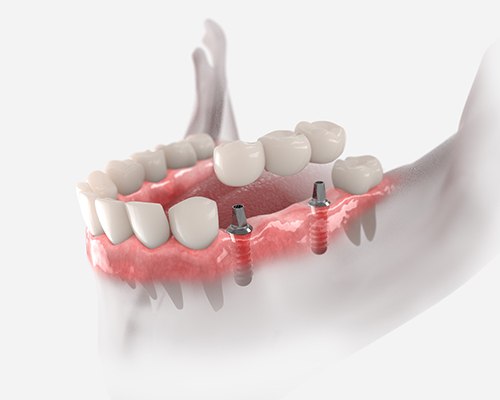
Instead of connecting to crowns that are attached to healthy teeth, implant bridges attach directly to the jaw. We can surgically place two small titanium rods into the jawbone, then attach the crowns to these implants.
This style of dental bridge has a level of stability and durability that the traditional method can’t match. Implant bridges also don’t require you to alter any healthy teeth, which is usually necessary with traditional dental bridges.
The Benefits of Getting a Dental Bridge

Some patients think that replacing missing teeth isn’t really worth the hassle, but dental bridges make it as simple and convenient as possible to fill gaps in your smile. They aren’t removable, meaning that they don’t require maintenance any different from the rest of your teeth.
Missing teeth has a ton of negative effects on your oral health, so it’s also important to replace them when you can. If you don’t, it’s common for the other teeth to start to move around to fill the gap, leading to alignment issues. Missing teeth can also give you plenty of difficulties eating and speaking properly, so dental bridges can give you back some of the things that matter most to you. All the more reason to give us a call for a consultation today!
Dental Bridges FAQs
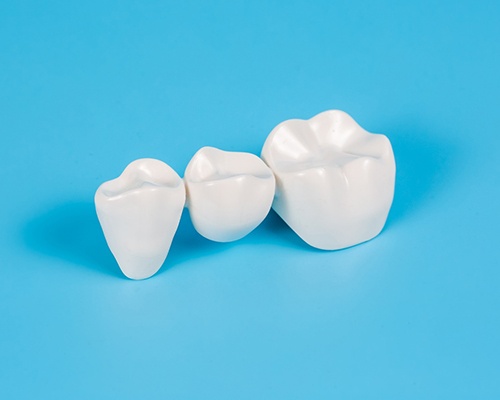
Among the various tooth replacement options on the market, dental bridges are the ones that people tend to know the least about on the surface. While getting a set of them isn’t all that intricate, it’s understandable to have a couple of questions about what the procedure entails, and what you can expect the final restoration to look like.
We want our patients to feel as comfortable and knowledgeable as possible before getting treatment, so here are answers to some of the questions you may have about dental bridges.
Is Getting a Dental Bridge Painful?
Before removing any of the enamel necessary to make room for the dental bridge, we’ll be sure to numb your mouth completely so that the treatment is as comfortable as possible.
After the treatment is complete, you’re likely to experience a little bit of sensitivity for a few days. Once your teeth are used to missing a little bit of enamel, that should fade pretty quickly.
Is a Partial Denture the Same as a Bridge?
Partial dentures are sometimes referred to as “removable bridges”, but that shouldn’t lead you to believe that they’re precisely the same thing. For one, partial dentures are designed to be removable, while dental bridges permanently adhere to the teeth themselves.
Partial dentures are also typically made of acrylic, while dental bridges are made of ceramic of some variety. Finally, dental bridges really only work when the teeth that you’re missing are consecutive, while partial dentures are capable of wrapping around the teeth in such a way that they can replace teeth in different locations.
Do Dental Bridges Look Natural?
We only make dental bridges out of the highest quality materials, and meticulously craft them to match the color and shape of your teeth. The ceramics we use look remarkably like natural enamel, so you can depend on your dental bridges to blend in almost imperceptibly with your smile.
You also won’t have to worry about your dental bridges falling out the way you might have to with dentures, which means that you can rely on their realism.
Can Dental Bridges Get Cavities?
The materials that dental bridges are made out of are completely resistant to the decay-causing bacteria that can attack the enamel. As a result, you don’t have to worry about your dental bridges developing cavities.
However, it is possible for bacteria to seep under the dental bridges and cause problems, especially if you don’t properly take care of them. This is even more true if the dental bridge is nearing the end of its lifespan. For both of these reasons, it’s important to see us often for routine checkups so that we can guarantee the integrity of your restoration.

